Airy function
In the physical sciences, the Airy function (or Airy function of the first kind) Ai(x) is a special function named after the British astronomer George Biddell Airy (1801–1892). The function Ai(x) and the related function Bi(x), are linearly independent solutions to the differential equation
known as the Airy equation or the Stokes equation. This is the simplest second-order linear differential equation with a turning point (a point where the character of the solutions changes from oscillatory to exponential).
The Airy function is the solution to time-independent Schrödinger equation for a particle confined within a triangular potential well and for a particle in a one-dimensional constant force field. For the same reason, it also serves to provide uniform semiclassical approximations near a turning point in the WKB approximation, when the potential may be locally approximated by a linear function of position. The triangular potential well solution is directly relevant for the understanding of electrons trapped in semiconductor heterojunctions.
The Airy function also underlies the form of the intensity near an optical directional caustic, such as that of the rainbow. Historically, this was the mathematical problem that led Airy to develop this special function.
A different function that is also named after Airy is important in microscopy and astronomy; it describes the pattern, due to diffraction and interference, produced by a point source of light (one which is much smaller than the resolution limit of a microscope or telescope).
Definitions

For real values of x, the Airy function of the first kind can be defined by the improper Riemann integral:
which converges by Dirichlet's test. For any real number there is positive real number such that function is increasing, unbounded and convex with continuous and unbounded derivative on interval . The convergence of the integral on this interval can be proven by Dirichlet's test after substitution .
y = Ai(x) satisfies the Airy equation
This equation has two linearly independent solutions. Up to scalar multiplication, Ai(x) is the solution subject to the condition y → 0 as x → ∞. The standard choice for the other solution is the Airy function of the second kind, denoted Bi(x). It is defined as the solution with the same amplitude of oscillation as Ai(x) as x → −∞ which differs in phase by π/2:
Properties
The values of Ai(x) and Bi(x) and their derivatives at x = 0 are given by
Here, Γ denotes the Gamma function. It follows that the Wronskian of Ai(x) and Bi(x) is 1/π.
When x is positive, Ai(x) is positive, convex, and decreasing exponentially to zero, while Bi(x) is positive, convex, and increasing exponentially. When x is negative, Ai(x) and Bi(x) oscillate around zero with ever-increasing frequency and ever-decreasing amplitude. This is supported by the asymptotic formulae below for the Airy functions.
The Airy functions are orthogonal[1] in the sense that
again using an improper Riemann integral.
Asymptotic formulae

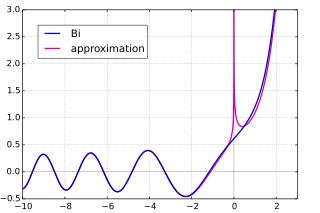
As explained below, the Airy functions can be extended to the complex plane, giving entire functions. The asymptotic behaviour of the Airy functions as |z| goes to infinity at a constant value of arg(z) depends on arg(z): this is called the Stokes phenomenon. For |arg(z)| < π we have the following asymptotic formula for Ai(z):[2]
and a similar one for Bi(z), but only applicable when |arg(z)| < π/3:
A more accurate formula for Ai(z) and a formula for Bi(z) when π/3 < |arg(z)| < π or, equivalently, for Ai(−z) and Bi(−z) when |arg(z)| < 2π/3 but not zero, are:[2][3]
When |arg(z)| = 0 these are good approximations but are not asymptotic because the ratio between Ai(−z) or Bi(−z) and the above approximation goes to infinity whenever the sine or cosine goes to zero. Asymptotic expansions for these limits are also available. These are listed in (Abramowitz and Stegun, 1954) and (Olver, 1974).
One is also able to obtain asymptotic expressions for that derivatives Ai'(z) and Bi'(z). Similarly to before, when |arg(z)|<π:[3]
When |arg(z)|<π/3 we have:[3]
Similarly, an expression for Ai'(−z) and Bi'(−z) when |arg(z)| < 2π/3 but not zero, are[3]
Complex arguments
We can extend the definition of the Airy function to the complex plane by
where the integral is over a path C starting at the point at infinity with argument −π/3 and ending at the point at infinity with argument π/3. Alternatively, we can use the differential equation y′′ − xy = 0 to extend Ai(x) and Bi(x) to entire functions on the complex plane.
The asymptotic formula for Ai(x) is still valid in the complex plane if the principal value of x2/3 is taken and x is bounded away from the negative real axis. The formula for Bi(x) is valid provided x is in the sector {x ∈ C : |arg(x)| < (π/3)−δ} for some positive δ. Finally, the formulae for Ai(−x) and Bi(−x) are valid if x is in the sector {x ∈ C : |arg(x)| < (2π/3)−δ}.
It follows from the asymptotic behaviour of the Airy functions that both Ai(x) and Bi(x) have an infinity of zeros on the negative real axis. The function Ai(x) has no other zeros in the complex plane, while the function Bi(x) also has infinitely many zeros in the sector {z ∈ C : π/3 < |arg(z)| < π/2}.
Plots
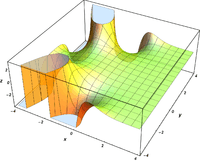 |
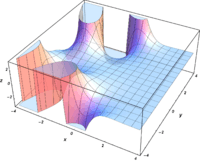 |
 |
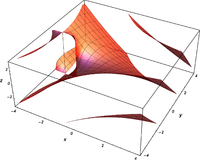 |
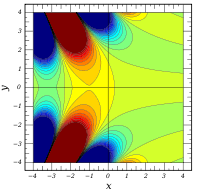 |
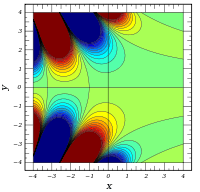 |
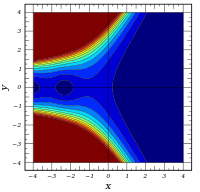 |
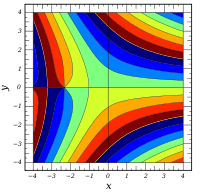 |
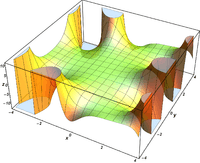 |
 |
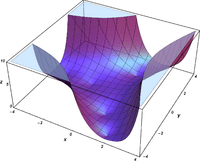 |
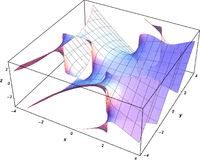 |
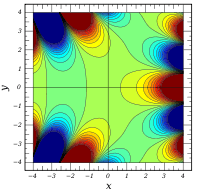 |
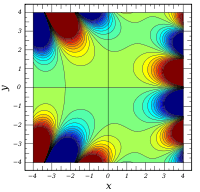 |
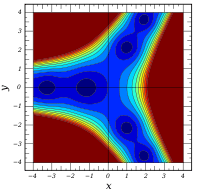 |
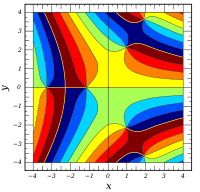 |
Relation to other special functions
For positive arguments, the Airy functions are related to the modified Bessel functions:
Here, I±1/3 and K1/3 are solutions of
The first derivative of the Airy function is
Functions K1/3 and K2/3 can be represented in terms of rapidly converged integrals[4] (see also modified Bessel functions )
For negative arguments, the Airy function are related to the Bessel functions:
Here, J±1/3 are solutions of
The Scorer's functions Hi(x) and -Gi(x) solve the equation y′′ − xy = 1/π. They can also be expressed in terms of the Airy functions:
Fourier transform
Using the definition of the Airy function Ai(x), it is straightforward to show its Fourier transform is given by
Other uses of the term Airy function
Transmittance of a Fabry–Pérot interferometer

The transmittance function of a Fabry–Pérot interferometer is also referred to as the Airy Function:[5]
where both surfaces have reflectance R and
is the coefficient of finesse.
Diffraction on a circular aperture
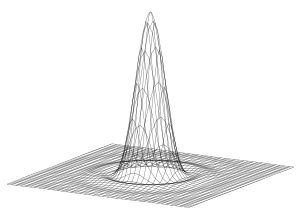
Independently, as a third meaning of the term, the shape of the Airy disk resulting from the wave diffraction on a circular aperture is sometimes also denoted as the Airy function (see e.g. here). This kind of function is closely related to the Bessel function.
History
The Airy function is named after the British astronomer and physicist George Biddell Airy (1801–1892), who encountered it in his early study of optics in physics (Airy 1838). The notation Ai(x) was introduced by Harold Jeffreys. Airy had become the British Astronomer Royal in 1835, and he held that post until his retirement in 1881.
See also
- The proof of Witten's conjecture used a matrix-valued generalization of the Airy function.
- Airy zeta function
Notes
- David E. Aspnes, Physical Review, 147, 554 (1966)
- Abramowitz & Stegun (1970, p. 448), Eqns 10.4.59, 10.4.61
- Abramowitz & Stegun (1970, p. 448), Eqns 10.4.60 and 10.4.64
- M.Kh.Khokonov. Cascade Processes of Energy Loss by Emission of Hard Photons // JETP, V.99, No.4, pp. 690-707 \ (2004).
- Hecht, Eugene (1987). Optics (2nd ed.). Addison Wesley. ISBN 0-201-11609-X. Sect. 9.6
References
- Abramowitz, Milton; Stegun, Irene Ann, eds. (1983) [June 1964]. "Chapter 10". Handbook of Mathematical Functions with Formulas, Graphs, and Mathematical Tables. Applied Mathematics Series. 55 (Ninth reprint with additional corrections of tenth original printing with corrections (December 1972); first ed.). Washington D.C.; New York: United States Department of Commerce, National Bureau of Standards; Dover Publications. p. 446. ISBN 978-0-486-61272-0. LCCN 64-60036. MR 0167642. LCCN 65-12253.
- Airy (1838), "On the intensity of light in the neighbourhood of a caustic", Transactions of the Cambridge Philosophical Society, University Press, 6: 379–402, Bibcode:1838TCaPS...6..379A
- Frank William John Olver (1974). Asymptotics and Special Functions, Chapter 11. Academic Press, New York.
- Press, WH; Teukolsky, SA; Vetterling, WT; Flannery, BP (2007), "Section 6.6.3. Airy Functions", Numerical Recipes: The Art of Scientific Computing (3rd ed.), New York: Cambridge University Press, ISBN 978-0-521-88068-8
- Vallée, Olivier; Soares, Manuel (2004), Airy functions and applications to physics, London: Imperial College Press, ISBN 978-1-86094-478-9, MR 2114198, archived from the original on 2010-01-13, retrieved 2010-05-14
External links
- "Airy functions", Encyclopedia of Mathematics, EMS Press, 2001 [1994]
- Weisstein, Eric W. "Airy Functions". MathWorld.
- Wolfram function pages for Ai and Bi functions. Includes formulas, function evaluator, and plotting calculator.
- Olver, F. W. J. (2010), "Airy and related functions", in Olver, Frank W. J.; Lozier, Daniel M.; Boisvert, Ronald F.; Clark, Charles W. (eds.), NIST Handbook of Mathematical Functions, Cambridge University Press, ISBN 978-0-521-19225-5, MR 2723248